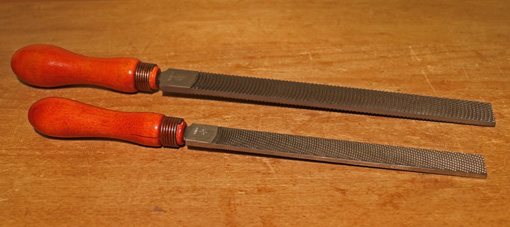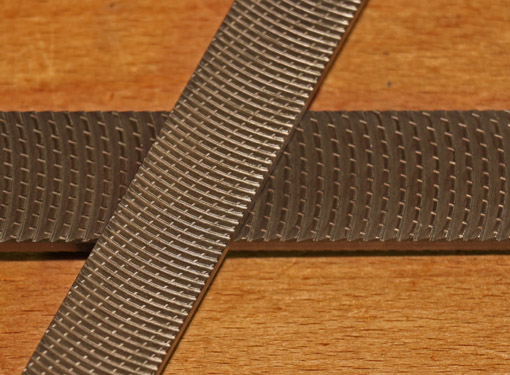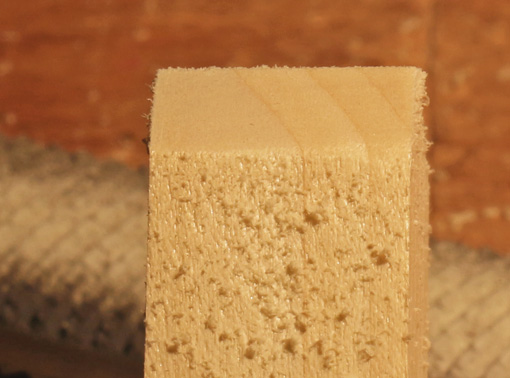
The teeth of a traditional woodworking float, very much unlike a rasp, span the full width of the tool. The cutting surface looks somewhat like a super-wide ripsaw. Iwasaki floats share some characteristics with traditional floats but have important differences in design.
These modern floats are remarkably smooth cutting and leave an amazingly smooth surface on the wood. They have almost no tendency to “catch” on the wood. They also allow great control to produce a true surface, such as in making fine adjustments to tenon cheeks. Aside from very hard steel and very sharp teeth, these floats have interesting features that contribute to their wonderful working properties.

As you can see from the photos, unlike a traditional float, each tooth row is discontinuous across its width. Furthermore, each row is curved so that most of the cutting edges are presented to the wood at a skew to the length of the tool. Each gap in the row is followed by a cutting edge just behind it. In this way, these tools act similarly to a segmented spiral cutterhead in a thickness planer, which is also very smooth cutting and produces small shavings and tearout-free surfaces.
This also helps reduce clogging in the floats. The wood that does accumulate in the grooves is easily cleared by tapping the tool or, more thoroughly, by brushing.
Click on the thumbnail (below) to see the macro photograph and note that below the leading faces of the teeth is a small curvilinear bump. This acts as a chipbreaker, further facilitating a smooth cut without tearout.
It is easy to get the feel of using these tools – use a firm but gentle approach to the wood. However, keep in mind that a skew is built in to the cutting edge. Since the tool is “pre-skewed,” your natural tendency to skew it as you would a rasp might work against you. If you use a skewed stroke, the actual presentation to the wood of one side of the tooth line is being less skewed and may tend to catch. The other side is being more skewed, and the tooth line may tend to slice along its length. This is more intuitive than it sounds and you will quickly work out an effective approach with the tool for the particular task at hand.
I’ve been using the 200 mm fine flat model for a few years now, and recently bought the coarse 10″ flat model. Even this, the coarsest grade, leaves a nice fine surface on the wood. The chamfer in the enlarged photo (below) is directly from this float.

Iwasaki floats come in coarse, medium, fine, and extra fine grades, and flat, half-round, round, curved, and plane maker’s models. Woodcraft, Lee Valley, The Best Things, and Highland Hardware have good, though different, selections. They’re a good buy.



Hey Rob, great information, heading for Woodcraft today. Did you make the handles? Hope all is well.
Interesting —
I have some Millenicut (straight grooves) and Dreadnought (curved grooves) files both milled teeth rather than chisel cut, and of extra hard finish – made and invented (1940s?) by Firth Brown Tools in Sheffield UK and extremely similar – on a quick search I see that these are still available new today at a lower price than the Iwasaki – Firth Brown doesn’t exist under that name any more, so I don’t know where made, maybe not Sheffield. They were and are available in 9, 13 and 18tpi.
Anyone compared the two?
I believe one difference might be that Iwasaki are chemically cut, not milled?
In any case the Millenicut and Dreadnought types give a good finish, even the 9tpi.
Danny (Sheffield, UK)
Thanks, Rick. I think you’ll like the Iwasakis. Bring a piece of scrap wood and see if you can try them out in the store. You may end up choosing a coarser model than you would first think.
The handles are old Disstons – best ever made, in my opinion. See this post: http://www.rpwoodwork.com/blog/2012/02/27/choosing-rasps-part-3/
Rob
Danny, thanks. Great information!
I see a Firth Brown in Canada. Though their sparse website does not mention files, it seems like they would manufacture them.
Readers, I note that TRS Supplies (UK) sells a tremendous selection of files, including the Dreadnought and Millenicut that Danny has introduced us to. http://www.trssupplies.co.uk/files-2190-c.asp They ship worldwide.
I see from the TRS website that the Dreadnoughts have curved, but not discontinuous, teeth. The Millenicut teeth are straight, in a double-cut pattern, which is effectively a discontinuous tooth pattern. Wow, they are usable on the “hardest steel.”
According to the Lee Valley description, the Iwasaki teeth are milled, then chemically etched to a sharp edge.
By the way, the Bahco file handles on the TRS site look good.
Thanks again for the info, Danny!
Rob
hi
good they may be, but I doubt they can cut the hardest steel (unless they mean in its soft state, before hardening) – they are steel themselves. although maybe induction hardened or even nitrided (like some automobile valves).
There is also an interesting variant on these dreadnoughts – a version with no tang or handle but countersunk holes front and rear to mount on a frame or for the user to add handle/tote and use like a plane.
regards again
Danny
I’ve been using the Iwasaki’s for about a year and a half now. Your comments about adjusting your approach to “angle of attack” are dead on. It’s different from a rasp or file. Leaves a terrific finish behind.
Danny,
Yes, I noticed that flexible plane version. It looks like the Nicholson version sold by Lee Valley but a lot cheaper. Thanks again.
Michael,
Thanks for the comment and thanks for reading. It is always helpful to hear the hands-on experience of fellow woodworkers.
Rob
Hi again — I had a chance to try a little-used millenicut 13tpi and a new Iwasaki 13tpi on the same piece of softwood at the same angle of cut — the Iwasaki cut just that very little bit deeper, both were equally smooth in finish, – the Iwasaki felt slightly sharper to the finger touch, but along with that you had to be more careful in approaching the wood to avoid a ‘catch’, or, worse, a damaging ‘skip’ as you might get cutting firewood with a very sharp bow saw — all this suggests to me that they have the same basis but that Iwasaki has that extra sharpness from the chem-etch, and needs a little more care/practice. All this is subjective of course – may get different results with different users, woods, angles.
On further searching I see the US made (no longer?) Shearcut and Vixen are rather similar; there was also a UK aero tool company which made or maybe just supplied Vixen files.
File handles — the UK ‘Python’ wooden handles are specifically for files and bargain priced (approx $1-2) each – ergonomically good but with a slightly tacky finish which is probably good for an oily metal shop, less pleasing to a woodworker.
Enough of files already.
Good woodworking
Danny
Danny,
Thanks for more helpful info. This is one of the things that makes blogging so useful. I appreciate your contributions.
Rob